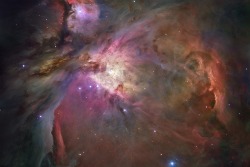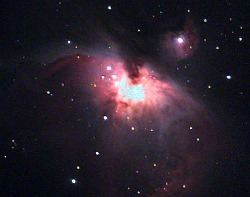Gems of the winter night sky
There are so many beautiful sights to see and so many amazing things to talk about in the night sky in any season of the year, but nothing surpasses what we find in the crystal clear night skies of winter. On this occasion, we will focus our attention on the constellations Orion the Hunter, Taurus the Bull and nearby stars that, generally speaking, are well-placed for viewing above the southern horizon from December to March. At no other time of the year do we find such a dazzling display of bright stars for viewing!
For my part I know nothing with any certainty, but the sight of the stars makes me dream. — Vincent van Gogh
We begin our tour of the region by referencing the three stars that form a nearly straight, diagonal line in the middle of the asterism that defines Orion the Hunter; the iconic, so-called Belt of the Hunter. Asterism is a star shape or pattern. Examples include: The Big Dipper; the essential shapes of Orion the Hunter or Taurus the Bull, the Summer Triangle, the Winter Triangle, etc.
To the bottom right of the belt, we find the bright, bluish-white star Rigel. To the upper left of the belt is the famous red star Betelgeuse. A red supergiant, Betelgeuse is a massive star that could undergo a supernova explosion near the end of its life cycle. It is some 500 light years from Earth. The speed of light is approximately 186,000 miles (or 300,000 kilometers) per second; denoted by the symbol “c.” A light year is the distance that light travels through empty space in one year; roughly 6 trillion miles or 10 trillion kilometers.
Betelgeuse is a favorite of many skygazers and is called, among other acceptable pronunciations (and to the delight of youngsters everywhere), “beetle-juice.” The root of the name is also interesting. It derives from the Arabic Ibt al Jauzah, which roughly translates as “the armpit of the Great One.” Both Betelgeuse and Rigel are among the most intrinsically powerful stars seen in the night sky, as each is tens of thousands of times more luminous than our own star, the Sun.

Below the belt, one can see a rather indistinct-looking set of stars that mark the sword of Orion. In clear, dark skies the middle “star” of the set of three stars appears to be a hazy patch of light to the naked eye. Viewed with binoculars, it becomes obvious that this “star” is actually a distinct, cloud-like object and not a star, at all. Indeed, this is the famous Great Nebula in Orion, M42. A remarkable region of star birth, a stellar nursery, the vast cloud of gas and dust is lit by the radiation from young stars cloaked within. This is the finest of nebulas that can easily be seen in northern skies.

Again using the belt stars of Orion, we follow along the diagonal line in both directions away from the constellation. A constellation is a particular region of the night sky. There are 88 constellations in the night sky.
To the lower left, the belt points to the brightest star in the sky, Sirius. Sirius is located in the constellation Canis Major (from the Latin, “Big Dog”). Considered a very special star in all ancient cultures, Sirius served as the important Dog Star for the ancient Egyptians, its appearance over the eastern horizon just before sunrise coinciding with the annual rising of the Nile and the beginning of the planting season. Sirius never gets very high above the southern horizon as it moves east to west across the sky through the night. Thus, as its light passes through more atmosphere on its way to our eyes, it flashes a variety of colors along with its brilliant blue-white light – sparkling like a diamond in the winter sky! And fairly routinely reported as a UFO!
To the upper right, the belt points into the constellation Taurus the Bull. We first come across a V-shape of stars which represents the face of the bull. Located some 137 light years away, this “V” is the nearest distinct open cluster of stars and is called the Hyades. The bright red star positioned at the end of one side of the V is Aldebaran, the eye of bull. The Hyades is a fine binocular object. Moving farther along, away from the belt, located on the shoulder of Taurus, we find the brightest open cluster of stars, known as the Pleiades, or Seven Sisters. This popular night sky object is located some 400 light years away and is a truly magnificent binocular object!
It is worth pointing out the reason that open clusters such as the Hyades and the Pleiades are touted as such fine binocular objects: Extended as they are across the sky, they do not easily fit within the more limited field of view of most telescopes, but nicely fit into the field of view of binoculars.
Another stunning member of the family of objects in Taurus is the Crab Nebula, M1. While not a binocular object and at best a faint patch of light in backyard telescopes, this nebula is worth mentioning because it is truly one of the most remarkable objects in the night sky. It is found just a little north and west of the star which is often pictured as the tip of the lower horn of the bull. A favorite of both professional and amateur astronomers, alike, the Crab Nebula is located some 5000 light years from Earth and is the remnant of a supernova explosion witnessed and chronicled by Chinese astronomers in 1054. Look for a story on the wonderful Crab Nebula in a future column.
To complete our look at Orion, Taurus and their surroundings, we point out the spectacular set of bright stars that complement the other stars already mentioned. High above Orion, near the top of the constellation Auriga, the Charioteer, is the sixth brightest star in the night skies, Capella. Above Orion and to the east lies the constellation Gemini and its bright stars Castor and Pollux. Below the twins of Gemini and straight east of Betelgeuse, we find Procyon, the bright star in Canis Minor, the Little Dog.
Indeed, Procyon, Betelgeuse and Sirius are seen as an asterism called the Winter Triangle.
By Jeff Conn